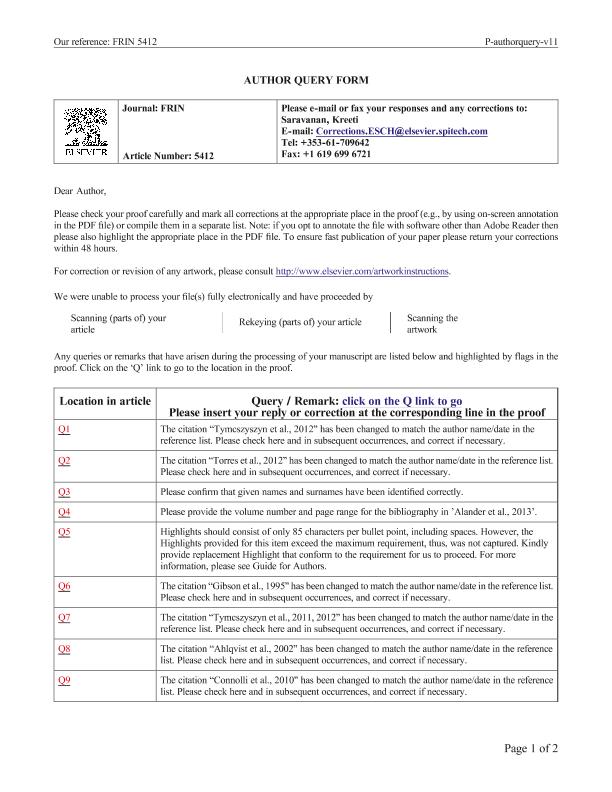Mostrar el registro sencillo del ítem
dc.contributor.author
Santos, Mauricio Ismael

dc.contributor.author
Araujo Andrade, Cuauhtémoc
dc.contributor.author
Tymczyszyn, Emma Elizabeth

dc.contributor.author
Gomez Zavaglia, Andrea

dc.date.available
2018-02-14T15:22:09Z
dc.date.issued
2014-10
dc.identifier.citation
Santos, Mauricio Ismael; Araujo Andrade, Cuauhtémoc; Tymczyszyn, Emma Elizabeth; Gomez Zavaglia, Andrea; Determination of amorphous/rubbery states in freeze-dried prebiotic sugars using a combined approach of near-infrared spectroscopy and multivariate analysis; Elsevier Science; Food Research International; 64; 10-2014; 514-519
dc.identifier.issn
0963-9969
dc.identifier.uri
http://hdl.handle.net/11336/36428
dc.description.abstract
Galacto-oligosaccharides (GOS) and lactulose are well-recognized prebiotics widely used in functional food and pharmaceutical products, but there is still a lack of knowledge regarding their physical–chemical properties. In this study, a physical–chemical approach on two GOS of different composition (GOS Cup Oligo H-70® and GOS Biotempo) and lactulose was assessed. Mid infrared and Raman spectra of the freeze-dried sugars allowed their structural characterization in the amorphous state, lactulose, showing the main spectral differences. Freeze-dried sugars were then equilibrated at 4 °C at relative humidity (RH) ranging from 11% to 80%. Near-infrared reflectance spectra were registered in each condition in the 900- to 1700-nm region. A principal component analysis (PCA) was performed on the three sugars equilibrated at different RH. In all the three sugars, the groups observed explained more than 95% of the variance and were related with the RH of the samples. According to the loading plots of PC1, the main differences related with RH were observed in the 1380- to 1500-nm region. As the amorphous states are very sensitive to changes in temperature and moisture content, and the moisture content is related with the parameter T-Tg (T: storage temperature; Tg: vitreous transition temperature), an effort was made to determine this parameter directly from the NIR spectra. To this aim, a partial least square model (PLS) was defined. Tg values obtained by differential scanning calorimetry (DSC) were used to calculate the T-Tg values of reference. The model was validated with an independent set of data. The mean of predicted values fitted nicely T-Tg obtained from DSC (correlation = 0.966; R2 = 0.934), thus supporting the use of the PLS model to investigate unknown samples. The stability of amorphous sugars in foods and pharmaceuticals is of practical and economical importance because it affects different quality attributes of foods, including texture, aroma retention and shelf life. Therefore, predicting T-Tg, a parameter that is independent on the sugar investigated, directly from their NIR spectra is of utmost importance to determine the shelf life of food and food-related products and up to our knowledge has never been determined hereto.
dc.format
application/pdf
dc.language.iso
eng
dc.publisher
Elsevier Science

dc.rights
info:eu-repo/semantics/openAccess
dc.rights.uri
https://creativecommons.org/licenses/by-nc-sa/2.5/ar/
dc.subject
Amorphous State
dc.subject
Vitreous Transition Temperature
dc.subject
T-Tg
dc.subject
Prebiotic
dc.subject
Near-Infrared Spectroscopy
dc.subject
Principal Component Analysis
dc.subject
Partial Least Square Analysis
dc.subject.classification
Alimentos y Bebidas

dc.subject.classification
Otras Ingenierías y Tecnologías

dc.subject.classification
INGENIERÍAS Y TECNOLOGÍAS

dc.title
Determination of amorphous/rubbery states in freeze-dried prebiotic sugars using a combined approach of near-infrared spectroscopy and multivariate analysis
dc.type
info:eu-repo/semantics/article
dc.type
info:ar-repo/semantics/artículo
dc.type
info:eu-repo/semantics/publishedVersion
dc.date.updated
2018-02-14T13:20:46Z
dc.journal.volume
64
dc.journal.pagination
514-519
dc.journal.pais
Países Bajos

dc.journal.ciudad
Amsterdam
dc.description.fil
Fil: Santos, Mauricio Ismael. Provincia de Buenos Aires. Gobernación. Comisión de Investigaciones Científicas. Centro de Investigación y Desarrollo en Criotecnología de Alimentos. Consejo Nacional de Investigaciones Científicas y Técnicas. Centro Científico Tecnológico Conicet - La Plata. Centro de Investigación y Desarrollo en Criotecnología de Alimentos. Universidad Nacional de La Plata. Facultad de Ciencias Exactas. Centro de Investigación y Desarrollo en Criotecnología de Alimentos; Argentina
dc.description.fil
Fil: Araujo Andrade, Cuauhtémoc. Universidad Autonoma de Zacatecas; México
dc.description.fil
Fil: Tymczyszyn, Emma Elizabeth. Provincia de Buenos Aires. Gobernación. Comisión de Investigaciones Científicas. Centro de Investigación y Desarrollo en Criotecnología de Alimentos. Consejo Nacional de Investigaciones Científicas y Técnicas. Centro Científico Tecnológico Conicet - La Plata. Centro de Investigación y Desarrollo en Criotecnología de Alimentos. Universidad Nacional de La Plata. Facultad de Ciencias Exactas. Centro de Investigación y Desarrollo en Criotecnología de Alimentos; Argentina
dc.description.fil
Fil: Gomez Zavaglia, Andrea. Provincia de Buenos Aires. Gobernación. Comisión de Investigaciones Científicas. Centro de Investigación y Desarrollo en Criotecnología de Alimentos. Consejo Nacional de Investigaciones Científicas y Técnicas. Centro Científico Tecnológico Conicet - La Plata. Centro de Investigación y Desarrollo en Criotecnología de Alimentos. Universidad Nacional de La Plata. Facultad de Ciencias Exactas. Centro de Investigación y Desarrollo en Criotecnología de Alimentos; Argentina
dc.journal.title
Food Research International

dc.relation.alternativeid
info:eu-repo/semantics/altIdentifier/doi/http://dx.doi.org/10.1016/j.foodres.2014.07.040
dc.relation.alternativeid
info:eu-repo/semantics/altIdentifier/url/https://www.sciencedirect.com/science/article/pii/S0963996914005171
Archivos asociados
